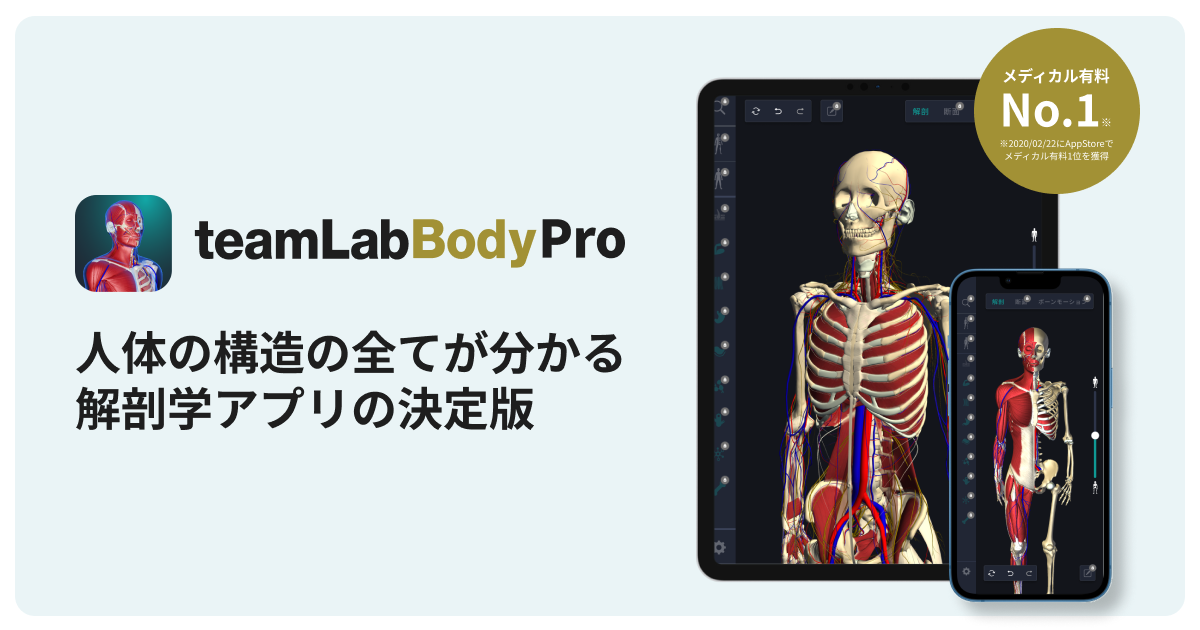beginning
In this article, I will explain the “adductor major muscle” in detail.
The adductor maximus muscle is a muscle associated with the abduction movement that pulls the leg to the center of the body. It is an important muscle that is essential not only for everyday movements such as walking or jumping, but also for sports such as soccer and tennis. Also, the adductor maximus muscle is involved in various foot movements such as knee flexion and hip rotation movements.
teamLab Body Pro Free Download
A 3D anatomy app that shows all the structures of the human body
Download teamLab Body Pro here!

How to read adductor maximus muscle
It is read as “dainai tenkin.” This muscle is commonly recognized in the fields of anatomy and sports science.
Characteristics of adductor maximus muscle
The adductor maximus muscle on the inside of the thigh is one of the largest muscle groups in the body. In addition to the inverted movement of the leg, the adductor maximus muscle also supports the pelvis and maintains a standing position. For athletes, training these muscles can improve performance and reduce the risk of injury.
Location and position of adductor major muscle

The adductor maximus muscle starts at the pelvic floor, passes through the inner thigh, and ends close to the knee. Seen from the front, it is difficult to recognize because it is located deep, but if you look at it from the inside using a human anatomy chart, etc., you can see the entire muscle.
How to memorize adductor maximus muscle
By memorizing it as “a large muscle that pulls the leg to the center of the body,” it becomes easier to understand the function and name of adductor maximus muscle. The name “adductor maximus muscle” itself indicates size and function.
English/Latin for adductor maximus muscle
The notation in English is “Addicted Magnus,” and in Latin it is “Musculus Addicted Magnus.” “Addicted” is a word meaning “inversion,” and “Magnus” means “big.” From this name, you can also read the characteristic that large muscles support adduction movements.
Trivia of adductor maximus muscle
Here's some trivia.
In sports where hip movements are frequently used, such as hockey and soccer, increasing the flexibility and strength of the adductor maximus muscle is directly linked to improved performance. However, care must be taken because the risk of injury increases without proper warm-up and care.
Tissues associated with adductor maximus muscle: characteristics of the femur
The femur is a very strong bone, and in addition to supporting body weight, various muscles attach to it and can receive force from multiple directions. The adductor maximus muscle is partially attached to the side near the middle of this bone, especially the part from the rough line (Linea aspera) close to the medial condyle of the femur. By adhering to the femur, the muscle fibers of the adductor major muscle control hip joint movement and enable abduction and extension.
Tissues related to adductor maximus muscle: location and position of the femur
The femur makes up the main part from the hip joint to the knee joint. This bone has a spherical femoral head at the upper end and connects to the pelvis at the hip joint. At the lower end, it connects to the tibia and forms the knee joint. There is a rough line on the back surface of the central part of the femur, and it is an insertion point for several muscles, including the adductor major muscle, and controls hip movement via the femur.
Tissues associated with adductor maximus muscle: trivia about the femur
Here's some trivia.
The femur is the longest bone and can weigh around 1 kg in adults. Also, it has a constricted shape in the middle. This constriction has a structure that optimally distributes the force applied to the femur.
Also, in the relationship between the femur and adductor maximus, the adductor maximus not only controls the movement of the femur, but also plays a role in stabilizing the hip joint. During movements such as walking or running, the adductor maximus transmits force through the femur and controls lower limb movements efficiently and accurately.
The relationship between the femur bone and adductor maximus muscle provides not only in terms of function, but also stability and harmony of movement for many movements performed on a daily basis. Such knowledge is also beneficial in the field of sports and rehabilitation, and is thought to help plan effective training and treatment.
Quizzes and correct answers for adductor maximus muscle
Q: Which movements of the knee are involved in the adductor maximus muscle?
A: Flexion
Q: Where does the adductor major muscle originate?
A: pubis
Q: What are the main functions of adductor maximus muscle?
A: leg inversion
summary
This time, I explained the location and location of the “great adductor muscle”, how to memorize it, and the English/Latin notation.
How was it?
I would be happy if reading this article deepened my understanding of anatomy.
Learning is a long, never-ending journey, but I sincerely wish you all the best. Let's continue to study together and work hard for the national exam!
Please look forward to the next blog.
Learn more with the anatomy app “TeamLabBody Pro”!
teamLabBody Pro is a “3D human anatomy application” that covers the entire body of the human body, including muscles, organs, nerves, bones and joints.
The human body is faithfully reproduced from CT and MRI data based on data from multiple subjects. Since medical book-level content supervised by physicians can be freely viewed from all angles, it can be used for various medical situations, such as explaining surgery to patients and studying anatomy for students.
If you want to see the parts introduced this time in more detail, please download the anatomy application “teamLabBody Pro.”
■teamLab Body Pro Free Download





